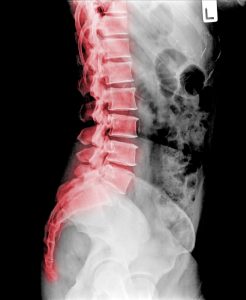Did you know that back pain is one of the most common reasons people visit an emergency room? This common ailment is experienced by about 80% of adults at some point of their life. The intensity of back pain can range from dull and achy to sudden and sharp. Today, let’s discuss risks, causes and treatments for back pain.
Causes of Back Pain
Some are born in pain, while others develop back pain through their lifetime. Several factors are generally attributed to their back problems. Despite all of these causes, more than 80% of today’s known cases have unidentified causes.
Causes of back pain may include the following:
-
 Sciatica – Pain that begins in the hip and buttocks continuing all the way down the leg. Sciatica indicates that the sciatic nerve is the cause of the pain in this condition.
Sciatica – Pain that begins in the hip and buttocks continuing all the way down the leg. Sciatica indicates that the sciatic nerve is the cause of the pain in this condition. - Herniated or ruptured discs – Also known as “bulging,” “ruptured,” or “torn” discs, herniated discs occur when the disc bulges out through the outer layer of ligaments surrounding the disc. Between each vertebra of the spine are spinal nerves that branch off from the spinal cord to a specific area in the body. If a disc is protruding on a spinal nerve, the pain can potentially spread to the area of the body that nerve serves. It is very common for disc ruptures to occur when a person is between 30-40 years of age.
- Scoliosis – Studies show that there are several causes of scoliosis such as congenital spine deformities, genetic conditions and/or osteoporosis. Adults can also develop scoliosis due to age-related wear and tear. Despite the broad list of causes, 80% of scoliosis cases have no known cause.
- Strains and Sprains – Either from a hard day’s work, sudden movements or physical activity, pain or an injury can often be sustained from a strain or sprain of the muscles and ligaments. Lower back strains or sprains are associated with activities such as bending, twisting and lifting heavy objects. Keep in mind that a strain is the tearing or overstretching of a ligament, while sprains are tears in tendons or muscles.
Risk Factors for Back Pain
According to the National Institute of Neurological Disorders and Strokes (NIH), several risks may be the culprit of our everyday back problems. These factors may include:
- Age – It’s common for older adults to be more susceptible than younger adults or children to back pain. Typically adults between the ages of 30-50 suffer back pain regularly. As we grow older osteoporosis, or the loss of bone strength, leads to fractures, loss of muscle elasticity and a decrease in tone.
- Mental Health Factors – Mental diseases such as anxiety or depression have been known to increase chances of back pain. Whether the conditions are pre-existing or develop from chronic back pain, these psychological factors can be major contributors.
- Weight Gain – The more overweight you are, the greater your risk of developing back pain among other ailments. Quickly gaining weight can increase your risk of back pain simply because the body is trying to balance out the weight placement and the pressure used on your back.
- Fitness Levels – Working from a desk all day can increase risk for back pain as well. Focusing on straightening your posture when either sitting or standing will help. Ideally, you should be able to sit upright in your chair with support in the small of your back. For keyboard users, keep your elbows at right angles and your forearms horizontal.
- Pregnancy – For many women, back pain during pregnancy is common due to pelvic changes and weight placement. Symptoms are almost always resolved postpartum.
[Tweet “Did you know that back pain is one of the most common reasons people visit an emergency room?”]
How to Tell if It’s a True Emergency
Although back pain is common, sometimes at-home treatments may not be enough. If you have one or more of the following conditions, speak with your doctor immediately:
- Fever
- Weight loss
- Swelling of the back
- Constant back pain – resting does not help
- Pain in the legs and below the knees
- Urinating unintentionally (even small amounts)
- Difficulty urinating
- Numbness around the genitals, anus or buttocks.
- People aged less than 20 and more than 55 years old
- Patients who have taken steroids for a few months
- Patients with or a history of cancer, or low immune systems
- Drug abusers
Treatments of Back Pain
Conventionally used methods for back pain generally depend on whether the pain is acute (lasting less than 3 to 6 months) or chronic (lasting longer than 6 months). The methods generally used are listed below.
-
 Medication – If your doctor prescribes you over-the-counter painkillers and it does not respond well, you may require a prescription non-steroidal anti-inflammatory drug (NSAID). Narcotics such as codeine or hydrocodone may also be prescribed for short periods and require close monitoring by the doctor. If you are suffering through depression, antidepressants, studies have shown, may alleviate your back pain.
Medication – If your doctor prescribes you over-the-counter painkillers and it does not respond well, you may require a prescription non-steroidal anti-inflammatory drug (NSAID). Narcotics such as codeine or hydrocodone may also be prescribed for short periods and require close monitoring by the doctor. If you are suffering through depression, antidepressants, studies have shown, may alleviate your back pain. - Hot or Cold Compresses – For temporary at-home relief, a hot or cold compress on the injured area is ideal. The results may be slow but compresses can help ease pain and reduce inflammation.
- Strengthening exercises – Exercising regularly will not only build strength in your back, it will also keep your body weight down. Low-impact aerobic activities that do not strain your back are key. Focus on exercises involved with your core and tuning up your flexibility to prevent back pain. Before you start any form of exercise program, talk to your health care professional.
Learning more about back pain can help you make a conscious decision on how to properly treat and monitor your condition. Using our gathered research and information, you can strengthen your back, potentially alleviate pain and regain your health. If you would like to see more on this topic, visit our YouTube channel to watch our Medical Monday video by our very own Dr. Grieves.
Sources:
http://www.back.com/back-pain/conditions/sciatica-pain-treatment/index.htm
http://www.medicalnewstoday.com/articles/172943.php?page=2
http://www.ninds.nih.gov/disorders/backpain/detail_backpain.htm
